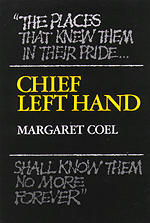






Chief Left Hand
Goin' Railroading



|
 |

 Chief Left Hand Excerpt
Chief Left Hand Excerpt
This is the story of one of the most famous Indians of the plains, a man about whom legends were made. In 1858, Chief Left Hand astonished the
early goldseekers in Colorado by greeting them in their own language. They were not the first white men he had known. He had dealt with whites all
his life and had learned to speak their language as a child.
The white men never forgot him. In time they gave his name to some of the places he had called home: Left Hand Canyon, in the foothills near
Boulder where he had spent each winter; the town of Niwot, his Arapaho name, close to where his village had stood; and Niwot Mountain, which
rises to the clouds among the Indian Peaks of the Rockies.
This is also the story of his people, the Southern Arapahos, during the most fateful years of their history. They were a gentle people, for the most
part, deeply religious, friendly, and generous. They were also canny businessmen, carrying on an extensive trade with whites and Indians across the
central plains. They called themselves Inunaina, which means "Our People," but their English name comes from the Pawnee word tirapihu ("trader").
As traders they preferred peace—and the uninterrupted flow of business—to war. Although young Arapaho warriors fought against their traditional
enemies, the Utes and the Pawnees, and eventually took arms against the whites, the Southern Arapahos as a tribe spent far more time and energy in
maintaining peace than in making war.
Both the Southern and the Northern Arapahos had preceded the white man to the plains by only about fifty years. Sometime in the dawn of their
history they had migrated westward from the mother tribe to which they belonged, the Great Algonquins, and in the intervening centuries had evolved
their own language and customs. Before the last half of the 1700s they had lived in the Red River country of Minnesota for as long as a thousand
years.
When other tribes and white men began moving into the Red River country, the Arapahos and the Cheyennes, also part of the Algonquins, began
moving out. The direction of their steady migration was south and west until around 1790, when they arrived on the central plains of Colorado,
Kansas, Nebraska, and Wyoming. The ponies they acquired from the Comanches gave them the freedom to follow the buffalo vast distances across
the open prairie, and by 1800 both tribes, now close allies, had settled in a new homeland.
Shortly thereafter, the Arapahos and Cheyennes both separated into their northern tribe, that half of the people who preferred the cooler climate
around the Bighorn and Powder rivers, and the southern tribe, those who liked the milder, warmer temperatures south of the Platte. The separation
was merely geographical; the Southern and Northern Arapahos remained one people. They traveled back and forth to visit one another, intermarried,
and maintained close relationships, as did the Southern and Northern Cheyennes.
When hordes of white men began migrating to the central plains in the mid-nineteenth century, there was no place left for the Indians to go. The
Southern Arapahos hoped to make an arrangement with the newcomers that would allow two different cultures to share the same vast land. To do
this, they relied upon Left Hand, the chief who could glimpse the white man's mind because he understood his language.
This is the story of that chief and his people during a time of change, a time that would alter their lives and the face of an entire region, a time of
endings and beginnings.
© Margaret Coel
Chief Left Hand: Southern Arapaho is available from your favorite bookstore or from the University of Oklahoma Press, 1-800-627-7377. ISBN:
0-8061-2030-4. $19.95.
|

|

